warning light JEEP COMPASS 2012 1.G User Guide
[x] Cancel search | Manufacturer: JEEP, Model Year: 2012, Model line: COMPASS, Model: JEEP COMPASS 2012 1.GPages: 108, PDF Size: 4.03 MB
Page 3 of 108
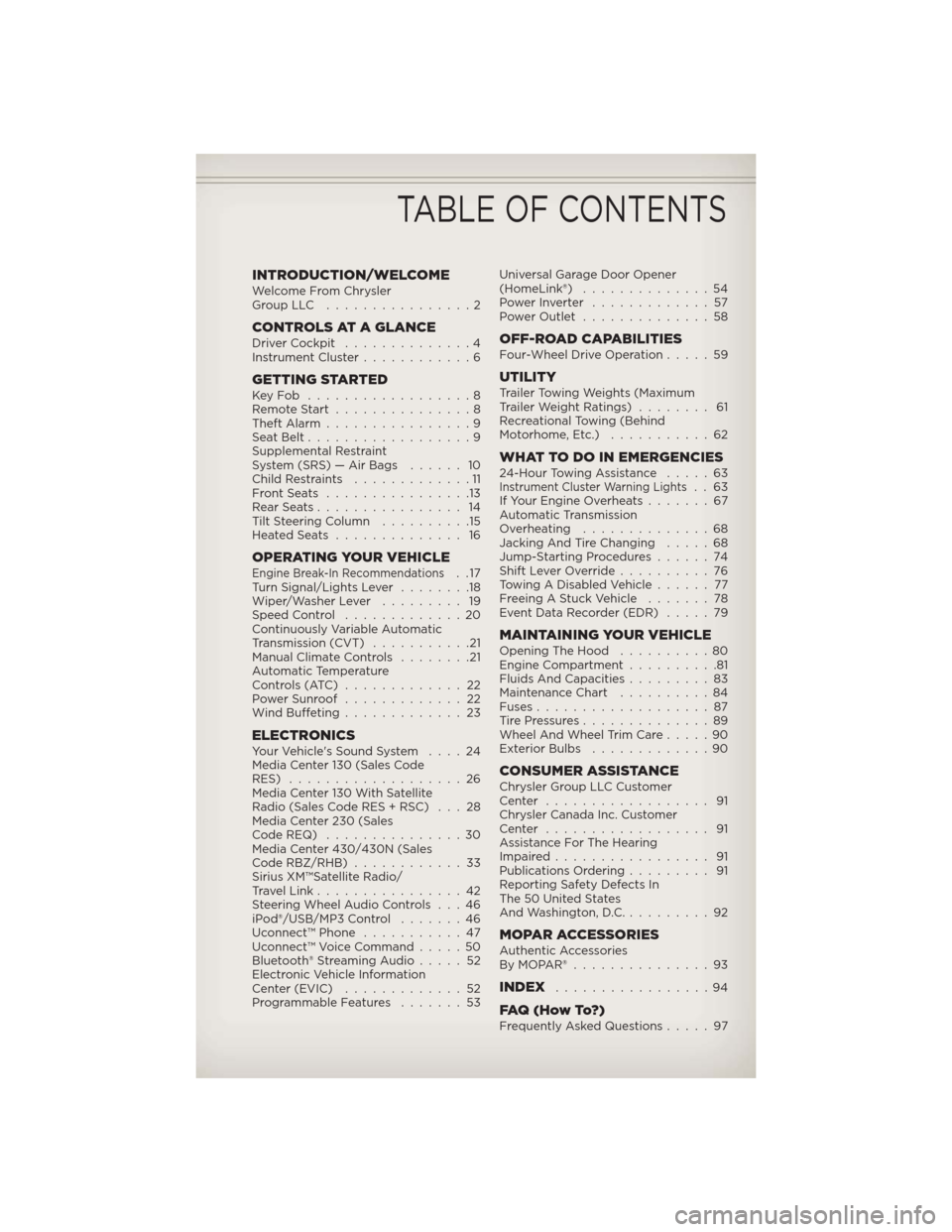
INTRODUCTION/WELCOMEWelcome From Chrysler
GroupLLC ................2
CONTROLS AT A GLANCEDriver Cockpit..............4
Instrument Cluster............6
GETTING STARTEDKeyFob ..................8
Remote Start...............8
Theft Alarm................9
Seat Belt..................9
Supplemental Restraint
System (SRS) — Air Bags...... 10
Child Restraints.............11
FrontSeats ................13
RearSeats................ 14
Tilt Steering Column..........15
HeatedSeats .............. 16
OPERATING YOUR VEHICLEEngine Break-In Recommendations..17
Turn Signal/Lights Lever........18
Wiper/Washer Lever......... 19
Speed Control.............20
Continuously Variable Automatic
Transmission (CVT)...........21
Manual Climate Controls........21
Automatic Temperature
Controls (ATC).............22
Power Sunroof.............22
Wind Buffeting.............23
ELECTRONICSYour Vehicle's Sound System....24
Media Center 130 (Sales Code
RES)...................26
Media Center 130 With Satellite
Radio (Sales Code RES + RSC) . . . 28
Media Center 230 (Sales
CodeREQ) ...............30
Media Center 430/430N (Sales
Code RBZ/RHB)............33
Sirius XM™Satellite Radio/
Travel Link................42
Steering Wheel Audio Controls . . . 46
iPod®/USB/MP3 Control.......46
Uconnect™ Phone...........47
Uconnect™ Voice Command.....50
Bluetooth® Streaming Audio.....52
Electronic Vehicle Information
Center (EVIC).............52
Programmable Features.......53Universal Garage Door Opener
(HomeLink®)..............54
PowerInverter .............57
Power Outlet..............58
OFF-ROAD CAPABILITIESFour-Wheel Drive Operation.....59
UTILITYTrailer Towing Weights (Maximum
Trailer Weight Ratings)........ 61
Recreational Towing (Behind
Motorhome, Etc.)...........62
WHAT TO DO IN EMERGENCIES24-Hour Towing Assistance.....63Instrument Cluster Warning Lights..63
If Your Engine Overheats.......67
Automatic Transmission
Overheating..............68
Jacking And Tire Changing.....68
Jump-Starting Procedures......74
Shift Lever Override..........76
Towing A Disabled Vehicle...... 77
Freeing A Stuck Vehicle.......78
Event Data Recorder (EDR).....79
MAINTAINING YOUR VEHICLEOpening The Hood..........80
Engine Compartment..........81
Fluids And Capacities.........83
Maintenance Chart..........84
Fuses...................87
TirePressures..............89
Wheel And Wheel Trim Care.....90
Exterior Bulbs.............90
CONSUMER ASSISTANCEChrysler Group LLC Customer
Center .................. 91
Chrysler Canada Inc. Customer
Center .................. 91
Assistance For The Hearing
Impaired................. 91
Publications Ordering......... 91
Reporting Safety Defects In
The 50 United States
And Washington, D.C..........92
MOPAR ACCESSORIESAuthentic Accessories
ByMOPAR®...............93
INDEX.................94
FAQ(HowTo?)Frequently Asked Questions.....97
TABLE OF CONTENTS
Page 8 of 108
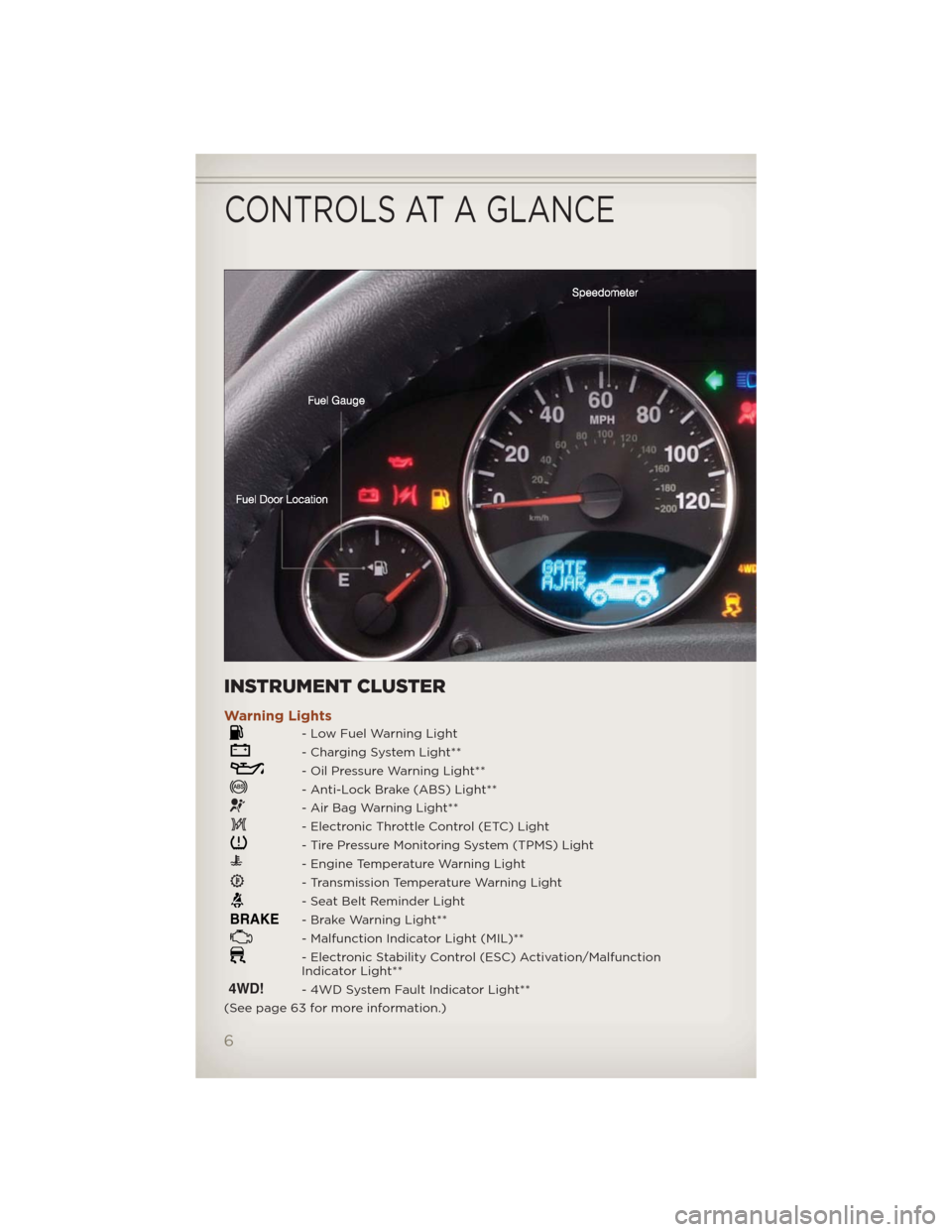
INSTRUMENT CLUSTER
Warning Lights
- Low Fuel Warning Light
- Charging System Light**
- Oil Pressure Warning Light**
- Anti-Lock Brake (ABS) Light**
- Air Bag Warning Light**
- Electronic Throttle Control (ETC) Light
- Tire Pressure Monitoring System (TPMS) Light
- Engine Temperature Warning Light
- Transmission Temperature Warning Light
- Seat Belt Reminder Light
BRAKE- Brake Warning Light**
- Malfunction Indicator Light (MIL)**
- Electronic Stability Control (ESC) Activation/Malfunction
Indicator Light**
4WD!- 4WD System Fault Indicator Light**
(See page 63 for more information.)
CONTROLS AT A GLANCE
6
Page 12 of 108
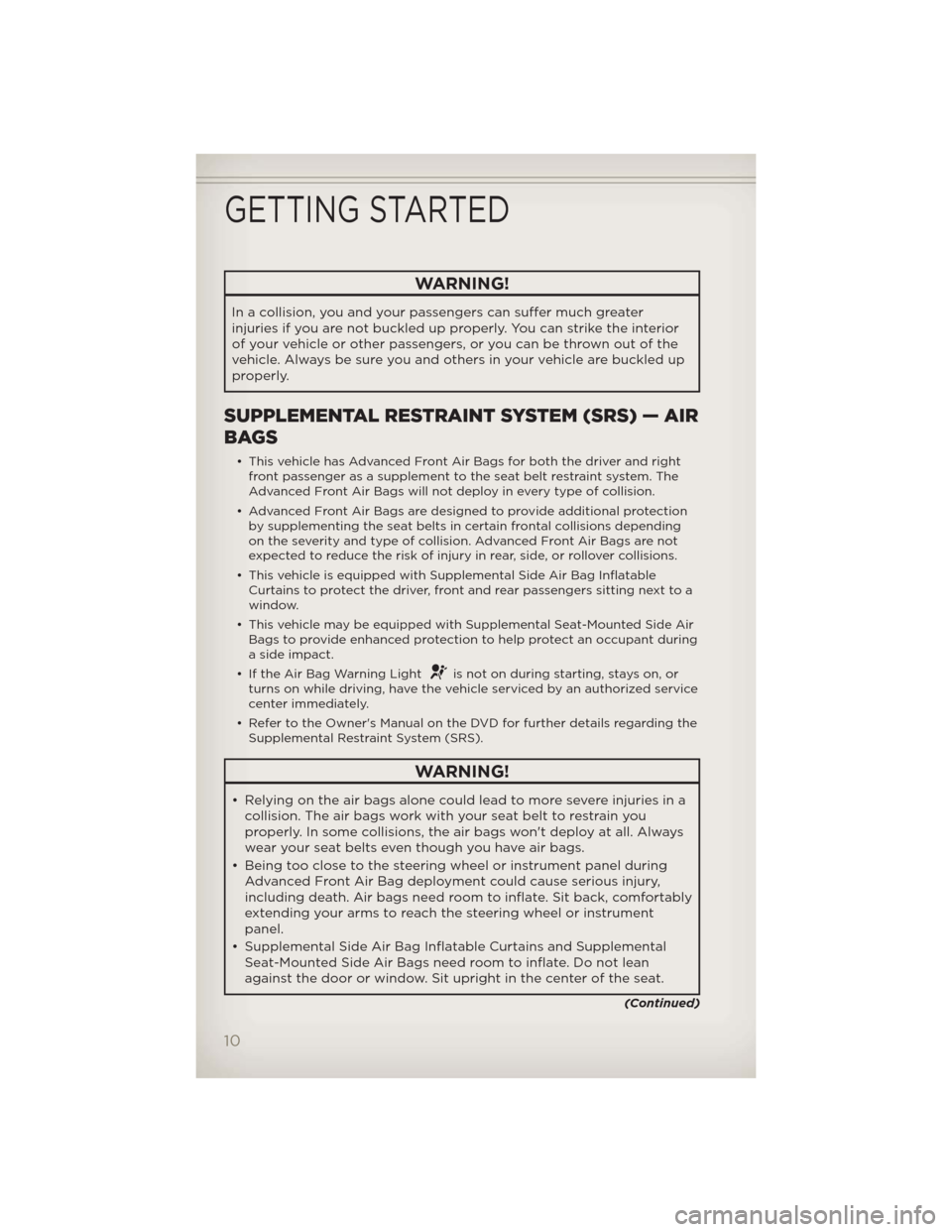
WARNING!
In a collision, you and your passengers can suffer much greater
injuries if you are not buckled up properly. You can strike the interior
of your vehicle or other passengers, or you can be thrown out of the
vehicle. Always be sure you andothers in your vehicle are buckled up
properly.
SUPPLEMENTAL RESTRAINT SYSTEM (SRS) — AIR
BAGS
• This vehicle has Advanced Front Air Bags for both the driver and right
front passenger as a supplement to the seat belt restraint system. The
Advanced Front Air Bags will not deploy in every type of collision.
• Advanced Front Air Bags are designed to provide additional protection
by supplementing the seat belts in certain frontal collisions depending
on the severity and type of collision. Advanced Front Air Bags are not
expected to reduce the risk of injury in rear, side, or rollover collisions.
• This vehicle is equipped with Supplemental Side Air Bag Inflatable
Curtains to protect the driver, front and rear passengers sitting next to a
window.
• This vehicle may be equipped with Supplemental Seat-Mounted Side Air
Bags to provide enhanced protection to help protect an occupant during
a side impact.
• If the Air Bag Warning Light
is not on during starting, stays on, or
turns on while driving, have the vehicle serviced by an authorized service
center immediately.
• Refer to the Owner's Manual on the DVD for further details regarding the
Supplemental Restraint System (SRS).
WARNING!
• Relying on the air bags alone could lead to more severe injuries in a
collision. The air bags work with your seat belt to restrain you
properly. In some collisions, the air bags won't deploy at all. Always
wear your seat belts even though you have air bags.
• Being too close to the steering wheel or instrument panel during
Advanced Front Air Bag deployment could cause serious injury,
including death. Air bags need room to inflate. Sit back, comfortably
extending your arms to reach the steering wheel or instrument
panel.
• Supplemental Side Air Bag Inflatable Curtains and Supplemental
Seat-Mounted Side Air Bags need room to inflate. Do not lean
against the door or window. Sit upright in the center of the seat.
(Continued)
GETTING STARTED
10
Page 58 of 108
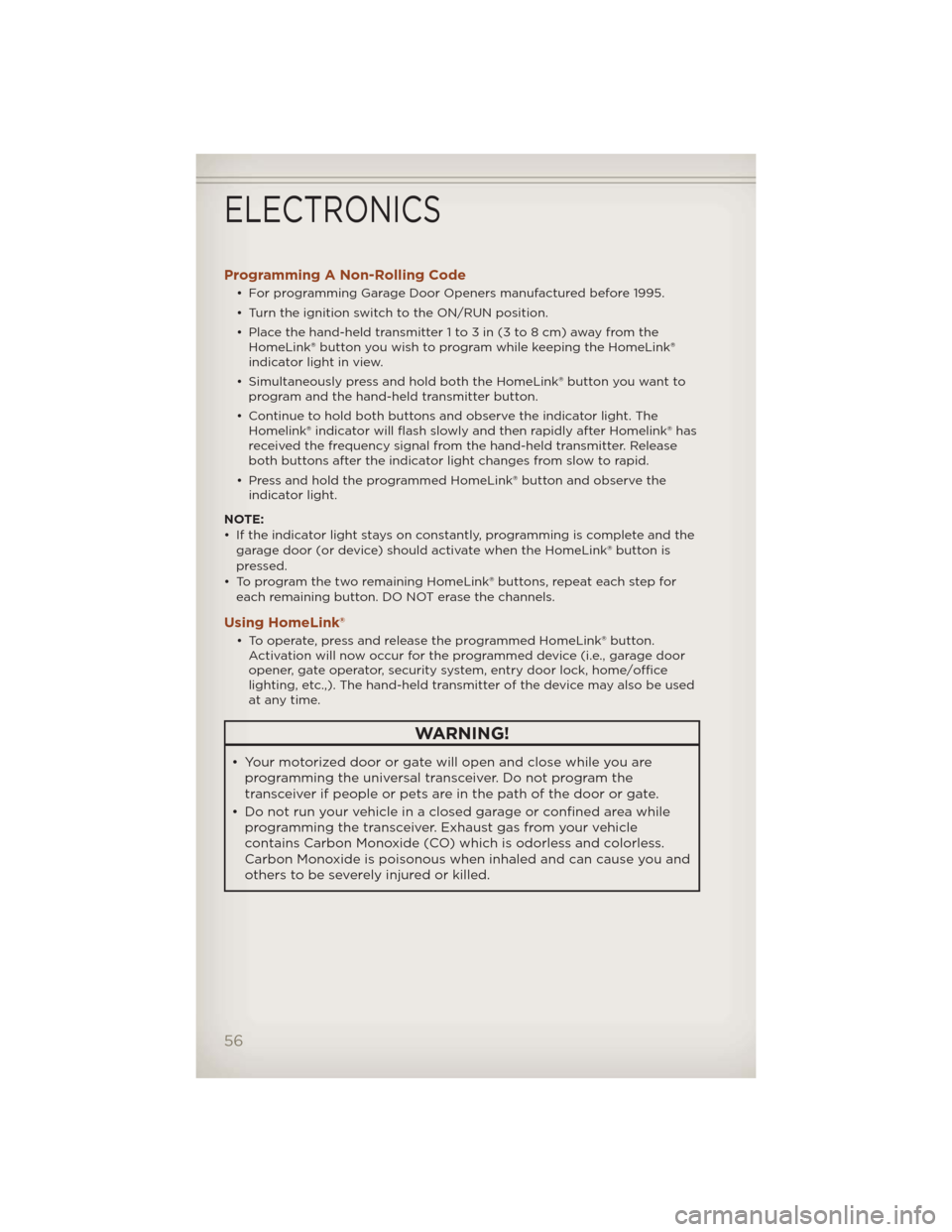
Programming A Non-Rolling Code
• For programming Garage Door Openers manufactured before 1995.
• Turn the ignition switch to the ON/RUN position.
• Place the hand-held transmitter 1 to 3 in (3 to 8 cm) away from the
HomeLink® button you wish to program while keeping the HomeLink®
indicator light in view.
• Simultaneously press and hold both the HomeLink® button you want to
program and the hand-held transmitter button.
• Continue to hold both buttons and observe the indicator light. The
Homelink® indicator will flash slowly and then rapidly after Homelink® has
received the frequency signal from the hand-held transmitter. Release
both buttons after the indicator light changes from slow to rapid.
• Press and hold the programmed HomeLink® button and observe the
indicator light.
NOTE:
• If the indicator light stays on constantly, programming is complete and the
garage door (or device) should activate when the HomeLink® button is
pressed.
• To program the two remaining HomeLink® buttons, repeat each step for
each remaining button. DO NOT erase the channels.
Using HomeLink®
• To operate, press and release the programmed HomeLink® button.
Activation will now occur for the programmed device (i.e., garage door
opener, gate operator, security system, entry door lock, home/office
lighting, etc.,). The hand-held transmitter of the device may also be used
at any time.
WARNING!
• Your motorized door or gate will open and close while you are
programming the universal transceiver. Do not program the
transceiver if people or pets are in the path of the door or gate.
• Do not run your vehicle in a closed garage or confined area while
programming the transceiver. Exhaust gas from your vehicle
contains Carbon Monoxide (CO) which is odorless and colorless.
Carbon Monoxide is poisonous when inhaled and can cause you and
others to be severely injured or killed.
ELECTRONICS
56
Page 65 of 108
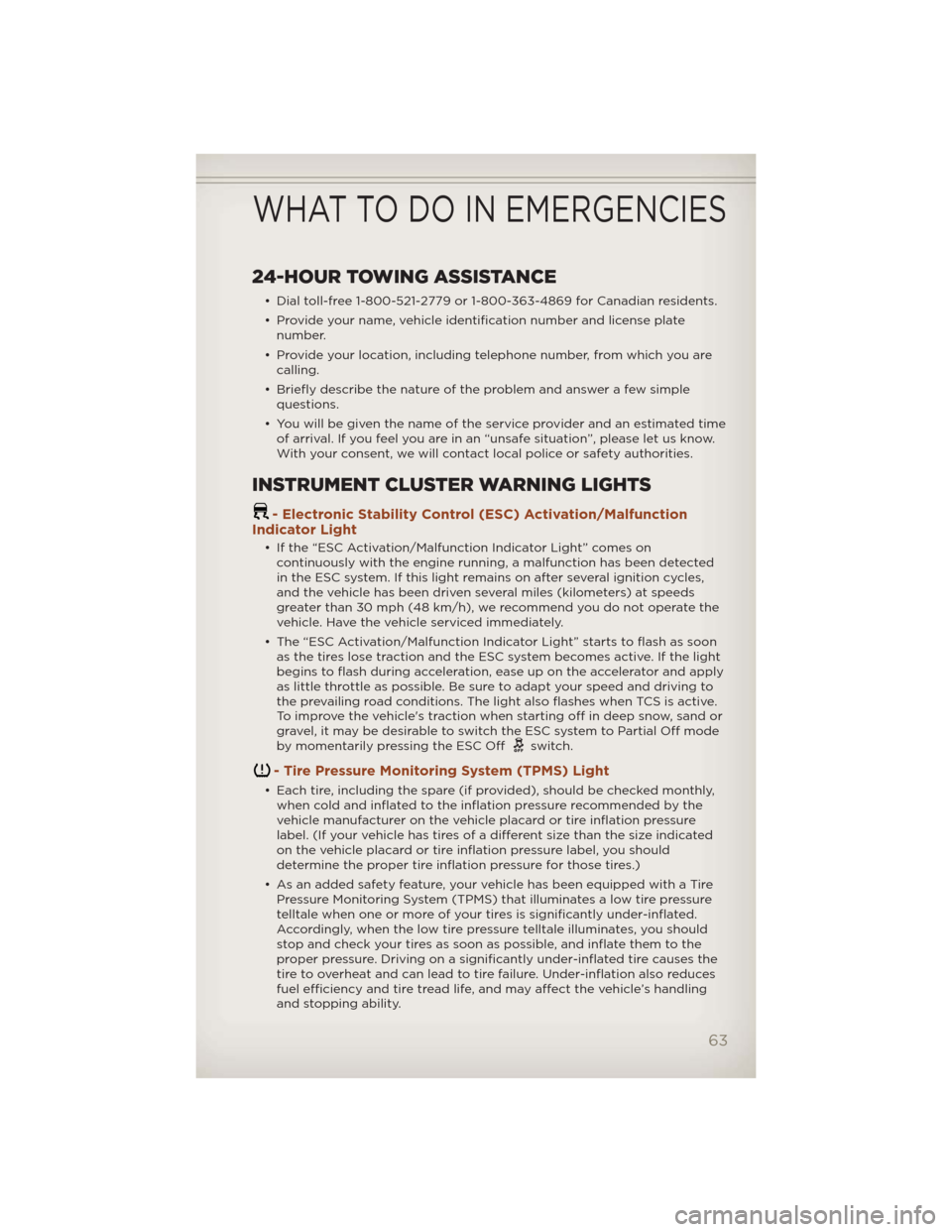
24-HOUR TOWING ASSISTANCE
• Dial toll-free 1-800-521-2779 or 1-800-363-4869 for Canadian residents.
• Provide your name, vehicle identification number and license plate
number.
• Provide your location, including telephone number, from which you are
calling.
• Briefly describe the nature of the problem and answer a few simple
questions.
• You will be given the name of the service provider and an estimated time
of arrival. If you feel you are in an “unsafe situation”, please let us know.
With your consent, we will contact local police or safety authorities.
INSTRUMENT CLUSTER WARNING LIGHTS
- Electronic Stability Control (ESC) Activation/Malfunction
Indicator Light
• If the “ESC Activation/Malfunction Indicator Light” comes on
continuously with the engine running, a malfunction has been detected
in the ESC system. If this light remains on after several ignition cycles,
and the vehicle has been driven several miles (kilometers) at speeds
greater than 30 mph (48 km/h), we recommend you do not operate the
vehicle. Have the vehicle serviced immediately.
• The “ESC Activation/Malfunction Indicator Light” starts to flash as soon
as the tires lose traction and the ESC system becomes active. If the light
begins to flash during acceleration, ease up on the accelerator and apply
as little throttle as possible. Be sure to adapt your speed and driving to
the prevailing road conditions. The light also flashes when TCS is active.
To improve the vehicle's traction when starting off in deep snow, sand or
gravel, it may be desirable to switch the ESC system to Partial Off mode
by momentarily pressing the ESC Off
switch.
- Tire Pressure Monitoring System (TPMS) Light
• Each tire, including the spare (if provided), should be checked monthly,
when cold and inflated to the inflation pressure recommended by the
vehicle manufacturer on the vehicle placard or tire inflation pressure
label. (If your vehicle has tires of a different size than the size indicated
on the vehicle placard or tire inflation pressure label, you should
determine the proper tire inflation pressure for those tires.)
• As an added safety feature, your vehicle has been equipped with a Tire
Pressure Monitoring System (TPMS) that illuminates a low tire pressure
telltale when one or more of your tires is significantly under-inflated.
Accordingly, when the low tire pressure telltale illuminates, you should
stop and check your tires as soon as possible, and inflate them to the
proper pressure. Driving on a significantly under-inflated tire causes the
tire to overheat and can lead to tire failure. Under-inflation also reduces
fuel efficiency and tire tread life, and may affect the vehicle’s handling
and stopping ability.
WHAT TO DO IN EMERGENCIES
63
Page 66 of 108
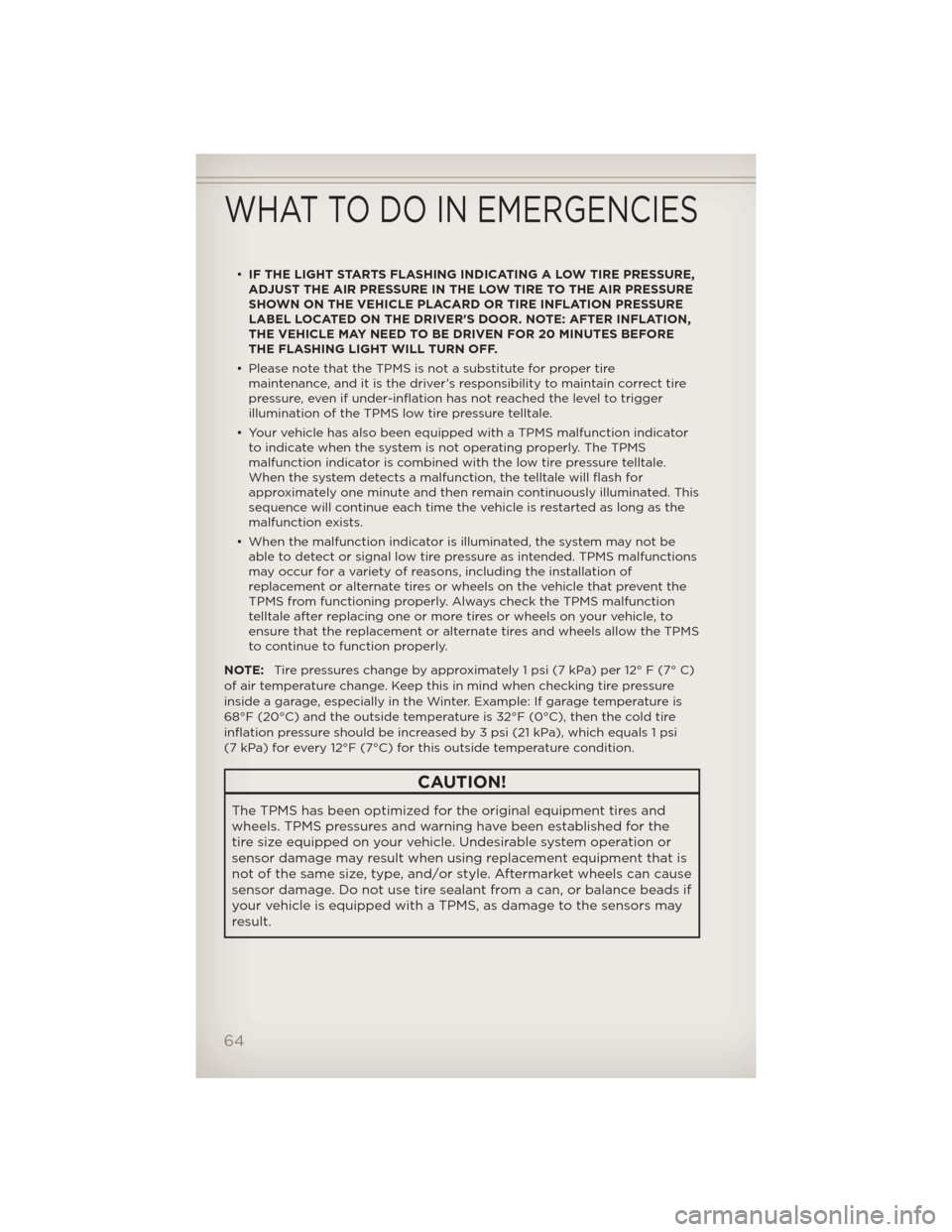
•IF THE LIGHT STARTS FLASHING INDICATING A LOW TIRE PRESSURE,
ADJUST THE AIR PRESSURE IN THE LOW TIRE TO THE AIR PRESSURE
SHOWN ON THE VEHICLE PLACARD OR TIRE INFLATION PRESSURE
LABEL LOCATED ON THE DRIVER'S DOOR. NOTE: AFTER INFLATION,
THE VEHICLE MAY NEED TO BE DRIVEN FOR 20 MINUTES BEFORE
THE FLASHING LIGHT WILL TURN OFF.
• Please note that the TPMS is not a substitute for proper tire
maintenance, and it is the driver’s responsibility to maintain correct tire
pressure, even if under-inflation has not reached the level to trigger
illumination of the TPMS low tire pressure telltale.
• Your vehicle has also been equipped with a TPMS malfunction indicator
to indicate when the system is not operating properly. The TPMS
malfunction indicator is combined with the low tire pressure telltale.
When the system detects a malfunction, the telltale will flash for
approximately one minute and then remain continuously illuminated. This
sequence will continue each time the vehicle is restarted as long as the
malfunction exists.
• When the malfunction indicator is illuminated, the system may not be
able to detect or signal low tire pressure as intended. TPMS malfunctions
may occur for a variety of reasons, including the installation of
replacement or alternate tires or wheels on the vehicle that prevent the
TPMS from functioning properly. Always check the TPMS malfunction
telltale after replacing one or more tires or wheels on your vehicle, to
ensure that the replacement or alternate tires and wheels allow the TPMS
to continue to function properly.
NOTE:Tire pressures change by approximately 1 psi (7 kPa) per 12° F (7° C)
of air temperature change. Keep this in mind when checking tire pressure
inside a garage, especially in the Winter. Example: If garage temperature is
68°F (20°C) and the outside temperature is 32°F (0°C), then the cold tire
inflation pressure should be increased by 3 psi (21 kPa), which equals 1 psi
(7 kPa) for every 12°F (7°C) for this outside temperature condition.
CAUTION!
The TPMS has been optimized for the original equipment tires and
wheels. TPMS pressures and warning have been established for the
tire size equipped on your vehicle. Undesirable system operation or
sensor damage may result when using replacement equipment that is
not of the same size, type, and/or style. Aftermarket wheels can cause
sensor damage. Do not use tire sealant from a can, or balance beads if
your vehicle is equipped with a TPMS, as damage to the sensors may
result.
WHAT TO DO IN EMERGENCIES
64
Page 67 of 108
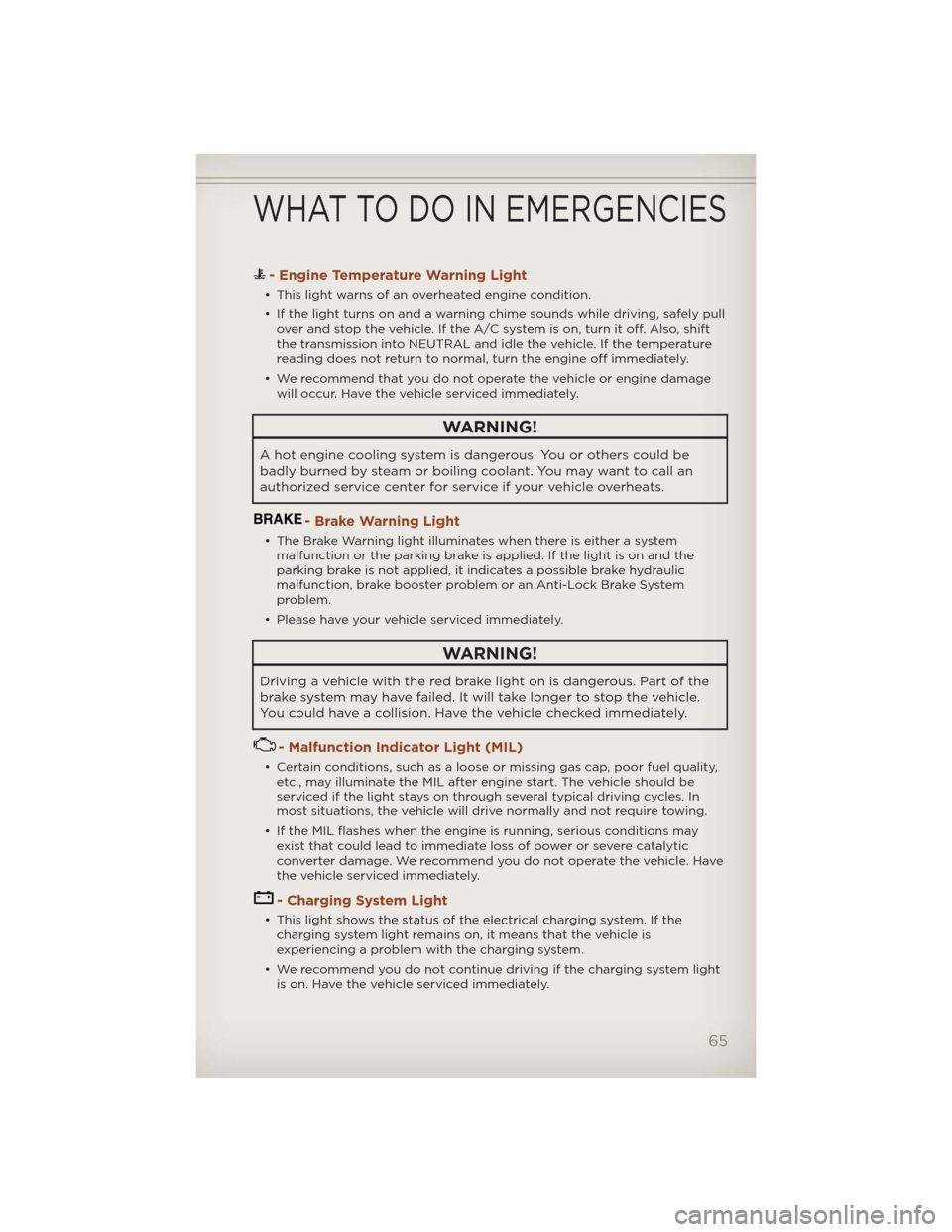
- Engine Temperature Warning Light
• This light warns of an overheated engine condition.
• If the light turns on and a warning chime sounds while driving, safely pull
over and stop the vehicle. If the A/C system is on, turn it off. Also, shift
the transmission into NEUTRAL and idle the vehicle. If the temperature
reading does not return to normal, turn the engine off immediately.
• We recommend that you do not operate the vehicle or engine damage
will occur. Have the vehicle serviced immediately.
WARNING!
A hot engine cooling system is dangerous. You or others could be
badly burned by steam or boiling coolant. You may want to call an
authorized service center for service if your vehicle overheats.
BRAKE- Brake Warning Light
• The Brake Warning light illuminates when there is either a system
malfunction or the parking brake is applied. If the light is on and the
parking brake is not applied, it indicates a possible brake hydraulic
malfunction, brake booster problem or an Anti-Lock Brake System
problem.
• Please have your vehicle serviced immediately.
WARNING!
Driving a vehicle with the red brake light on is dangerous. Part of the
brake system may have failed. It will take longer to stop the vehicle.
You could have a collision. Have the vehicle checked immediately.
- Malfunction Indicator Light (MIL)
• Certain conditions, such as a loose or missing gas cap, poor fuel quality,
etc., may illuminate the MIL after engine start. The vehicle should be
serviced if the light stays on through several typical driving cycles. In
most situations, the vehicle will drive normally and not require towing.
• If the MIL flashes when the engine is running, serious conditions may
exist that could lead to immediate loss of power or severe catalytic
converter damage. We recommend you do not operate the vehicle. Have
the vehicle serviced immediately.
- Charging System Light
• This light shows the status of the electrical charging system. If the
charging system light remains on, it means that the vehicle is
experiencing a problem with the charging system.
• We recommend you do not continue driving if the charging system light
is on. Have the vehicle serviced immediately.
WHAT TO DO IN EMERGENCIES
65
Page 68 of 108
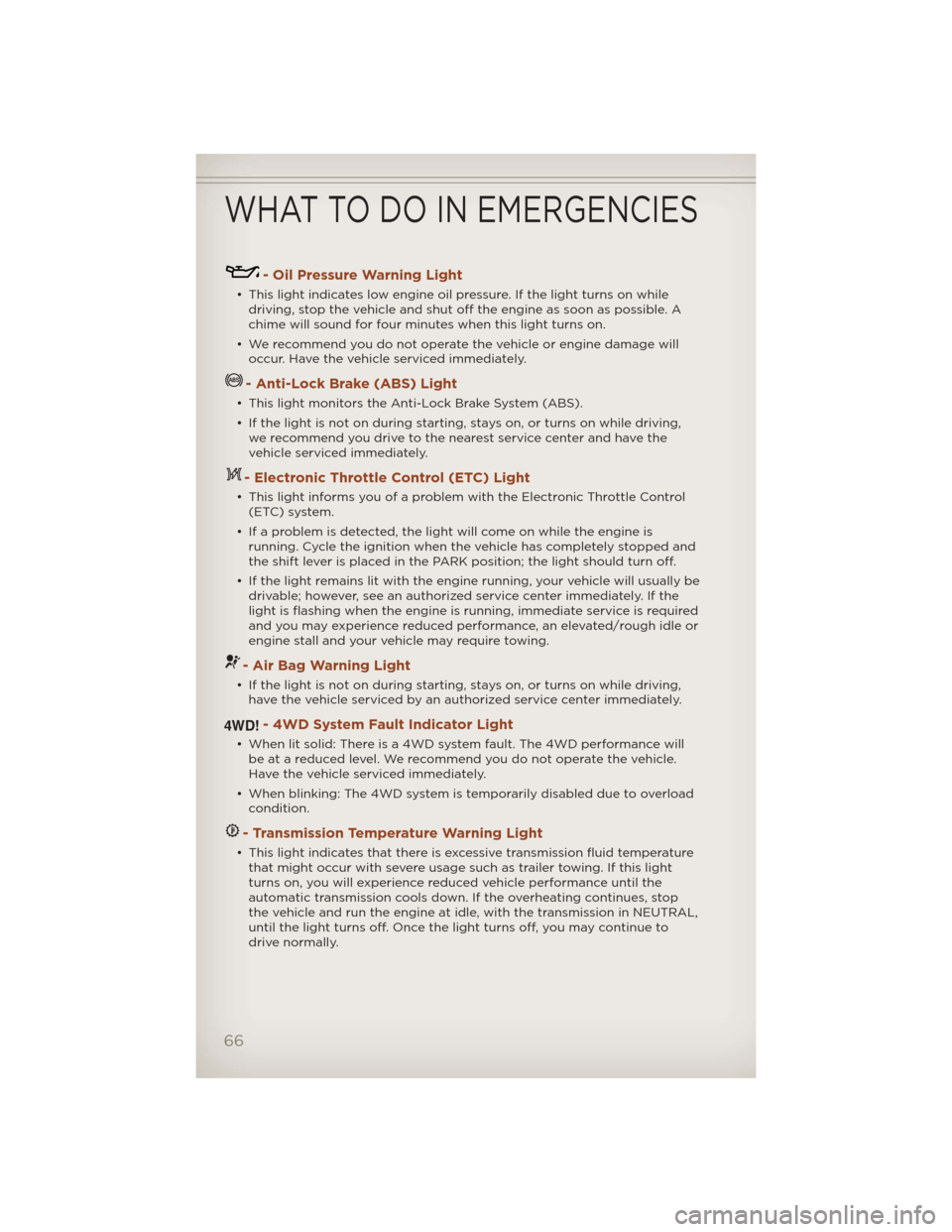
- Oil Pressure Warning Light
• This light indicates low engine oil pressure. If the light turns on while
driving, stop the vehicle and shut off the engine as soon as possible. A
chime will sound for four minutes when this light turns on.
• We recommend you do not operate the vehicle or engine damage will
occur. Have the vehicle serviced immediately.
- Anti-Lock Brake (ABS) Light
• This light monitors the Anti-Lock Brake System (ABS).
• If the light is not on during starting, stays on, or turns on while driving,
we recommend you drive to the nearest service center and have the
vehicle serviced immediately.
- Electronic Throttle Control (ETC) Light
• This light informs you of a problem with the Electronic Throttle Control
(ETC) system.
• If a problem is detected, the light will come on while the engine is
running. Cycle the ignition when the vehicle has completely stopped and
the shift lever is placed in the PARK position; the light should turn off.
• If the light remains lit with the engine running, your vehicle will usually be
drivable; however, see an authorized service center immediately. If the
light is flashing when the engine is running, immediate service is required
and you may experience reduced performance, an elevated/rough idle or
engine stall and your vehicle may require towing.
- Air Bag Warning Light
• If the light is not on during starting, stays on, or turns on while driving,
have the vehicle serviced by an authorized service center immediately.
4WD!- 4WD System Fault Indicator Light
• When lit solid: There is a 4WD system fault. The 4WD performance will
be at a reduced level. We recommend you do not operate the vehicle.
Have the vehicle serviced immediately.
• When blinking: The 4WD system is temporarily disabled due to overload
condition.
- Transmission Temperature Warning Light
• This light indicates that there is excessive transmission fluid temperature
that might occur with severe usage such as trailer towing. If this light
turns on, you will experience reduced vehicle performance until the
automatic transmission cools down. If the overheating continues, stop
the vehicle and run the engine at idle, with the transmission in NEUTRAL,
until the light turns off. Once the light turns off, you may continue to
drive normally.
WHAT TO DO IN EMERGENCIES
66
Page 70 of 108
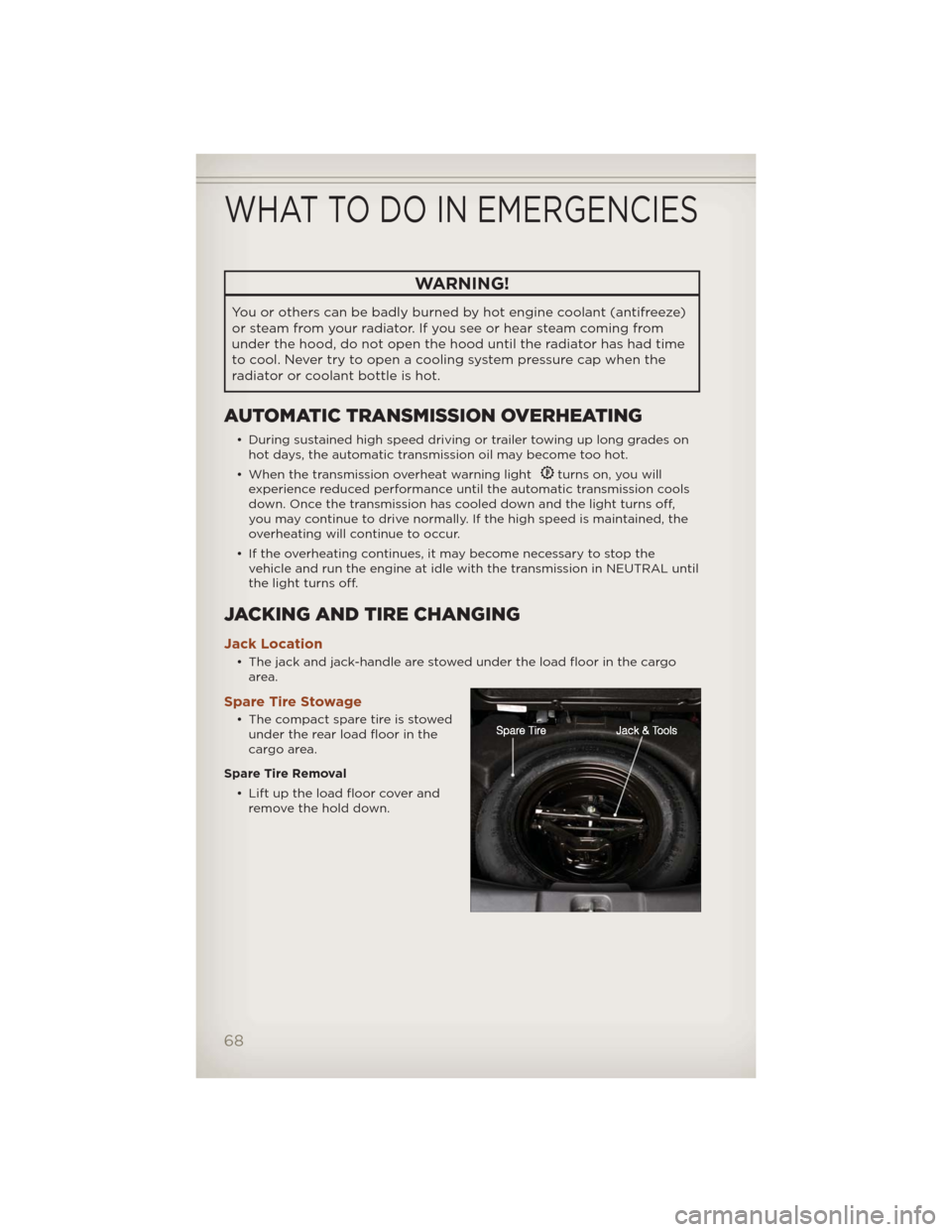
WARNING!
You or others can be badly burned by hot engine coolant (antifreeze)
or steam from your radiator. If you see or hear steam coming from
under the hood, do not open the hood until the radiator has had time
to cool. Never try to open a cooling system pressure cap when the
radiator or coolant bottle is hot.
AUTOMATIC TRANSMISSION OVERHEATING
• During sustained high speed driving or trailer towing up long grades on
hot days, the automatic transmission oil may become too hot.
• When the transmission overheat warning light
turns on, you will
experience reduced performance until the automatic transmission cools
down. Once the transmission has cooled down and the light turns off,
you may continue to drive normally. If the high speed is maintained, the
overheating will continue to occur.
• If the overheating continues, it may become necessary to stop the
vehicle and run the engine at idle with the transmission in NEUTRAL until
the light turns off.
JACKING AND TIRE CHANGING
Jack Location
• The jack and jack-handle are stowed under the load floor in the cargo
area.
Spare Tire Stowage
• The compact spare tire is stowed
under the rear load floor in the
cargo area.
Spare Tire Removal
• Lift up the load floor cover and
remove the hold down.
WHAT TO DO IN EMERGENCIES
68
Page 96 of 108
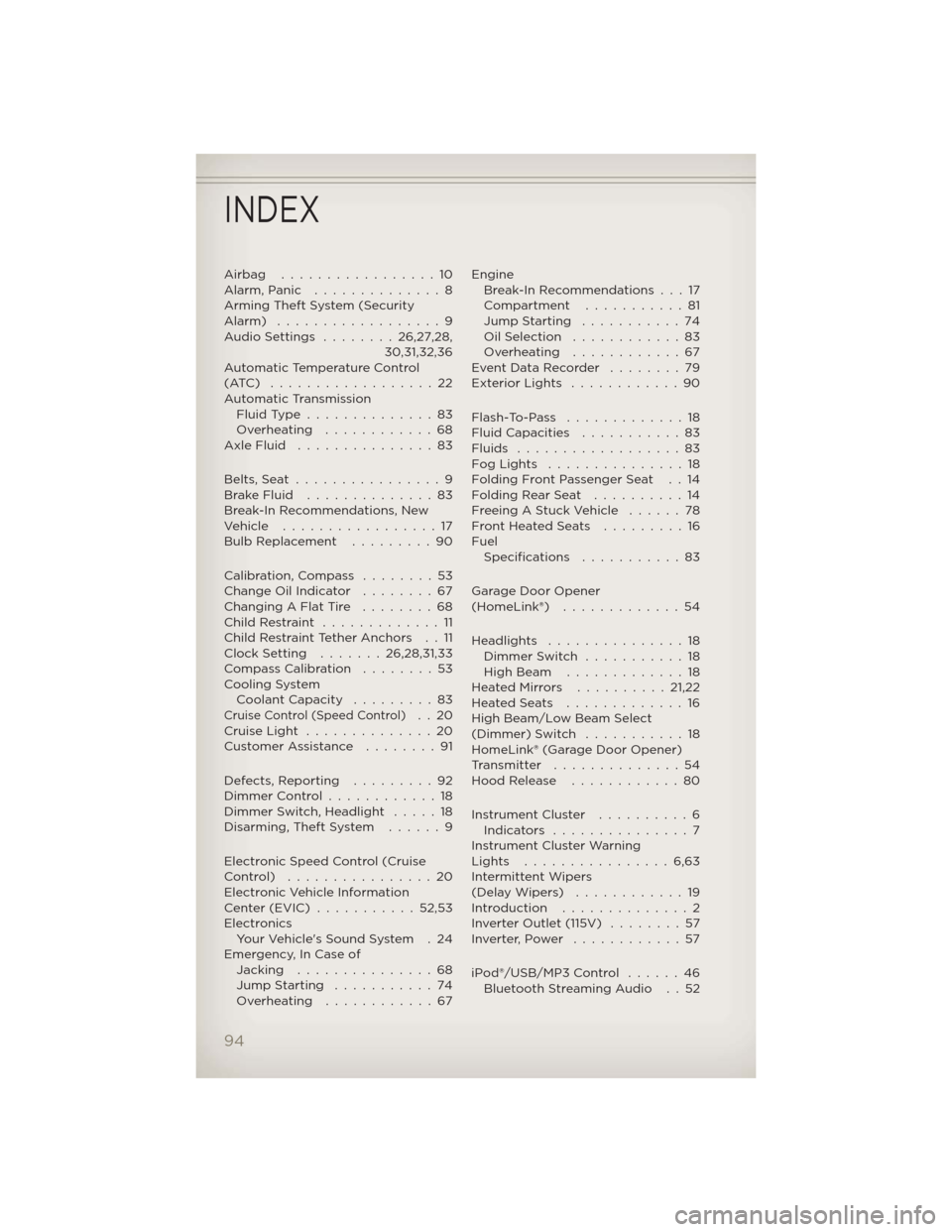
Airbag .................10
Alarm,Panic ..............8
Arming Theft System (Security
Alarm) ..................9
AudioSettings ........26,27,28,
30,31,32,36
Automatic Temperature Control
(ATC) ..................22
Automatic Transmission
FluidType..............83
Overheating ............68
AxleFluid ...............83
Belts, Seat................9
BrakeFluid ..............83
Break-In Recommendations, New
Vehicle .................17
Bulb Replacement.........90
Calibration, Compass........53
Change Oil Indicator........67
Changing A Flat Tire........68
ChildRestraint .............11
Child Restraint Tether Anchors . . 11
Clock Setting.......26,28,31,33
Compass Calibration........53
Cooling System
Coolant Capacity.........83
Cruise Control (Speed Control)..20
CruiseLight ..............20
Customer Assistance........91
Defects, Reporting.........92
Dimmer Control............18
Dimmer Switch, Headlight.....18
Disarming, Theft System . . . . . . 9
Electronic Speed Control (Cruise
Control) ................20
Electronic Vehicle Information
Center(EVIC) ...........52,53
Electronics
Your Vehicle's Sound System . 24
Emergency, In Case of
Jacking...............68
Jump Starting...........74
Overheating ............67Engine
Break-In Recommendations . . . 17
Compartment . . . . . . . . . . . 81
Jump Starting...........74
OilSelection ............83
Overheating ............67
Event Data Recorder . . . . . . . . 79
Exterior Lights . . . . . . . . . . . . 90
Flash-To-Pass .............18
Fluid Capacities . . . . . . . . . . . 83
Fluids ..................83
FogLights ...............18
Folding Front Passenger Seat . . 14
FoldingRearSeat ..........14
Freeing A Stuck Vehicle . . . . . . 78
Front Heated Seats . . . . . . . . . 16
Fuel
Specifications . . . . . . .....83
Garage Door Opener
(HomeLink®) . . ...........54
Headlights . . . . . . . . . . . . . . . 18
Dimmer Switch . . . . . . . . . . . 18
High Beam . . . . . . . . . . . . . 18
HeatedMirrors ..........21,22
HeatedSeats .............16
High Beam/Low Beam Select
(Dimmer) Switch . . . . . . . . . . . 18
HomeLink® (Garage Door Opener)
Transmitter . . . . . . . . . . . . . . 54
Hood Release . . . . . . . . . . . . 80
Instrument Cluster . . . . . . . . . . 6
Indicators ...............7
Instrument Cluster Warning
Lights ................6,63
Intermittent Wipers
(DelayWipers) ............19
Introduction . . . . . . . . ......2
Inverter Outlet (115V) . . . . . . . . 57
Inverter,Power ............57
iPod®/USB/MP3 Control . . . . . . 46
Bluetooth Streaming Audio . . 52
INDEX
94